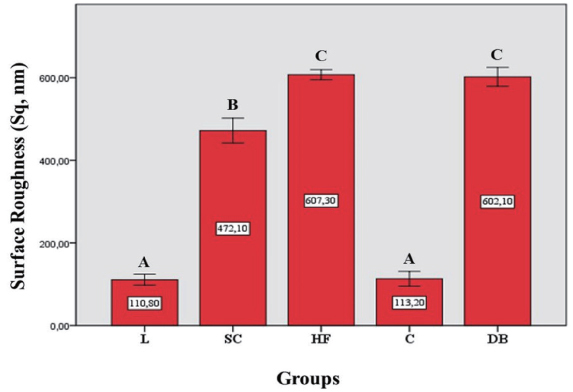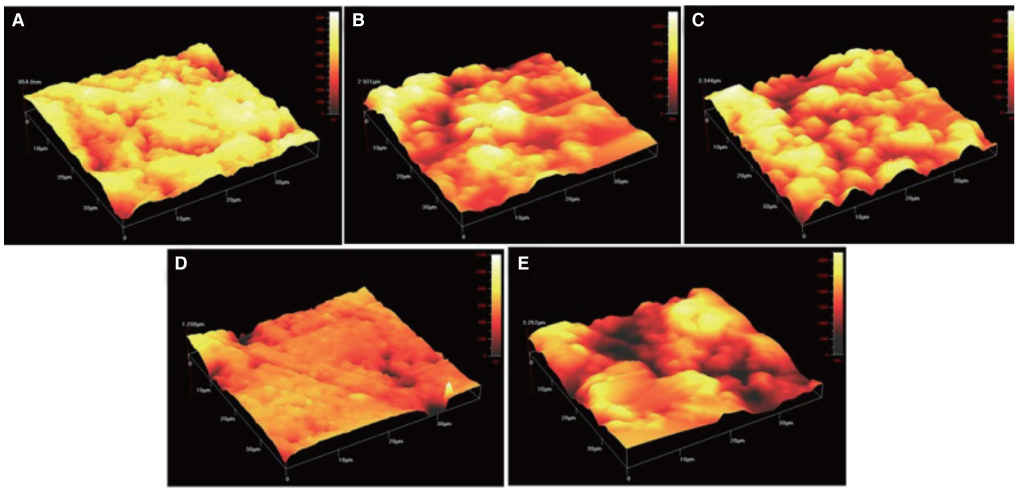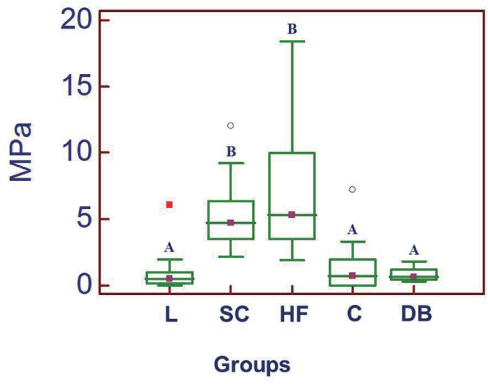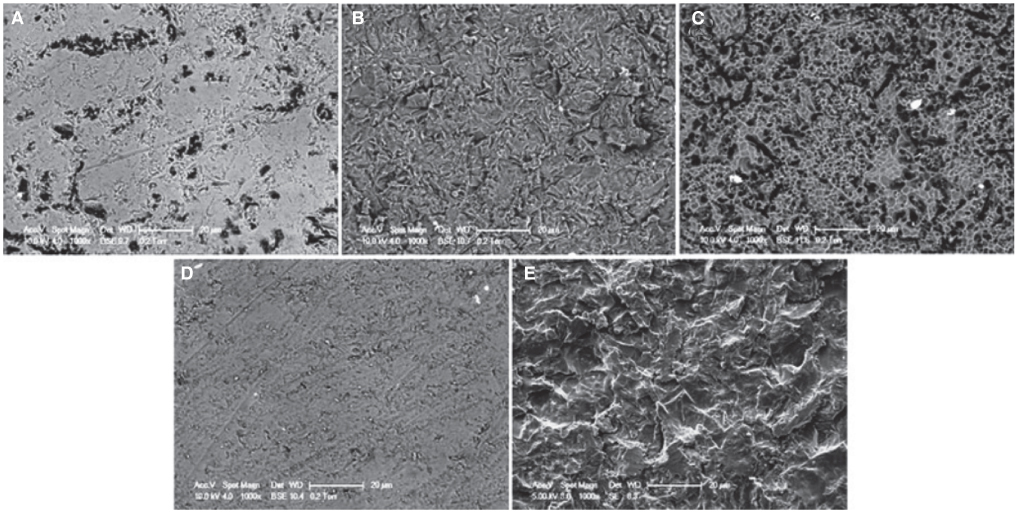J Adv Prosthodont.
2014 Dec;6(6):434-443. 10.4047/jap.2014.6.6.434.
Shear bond strength of a new self-adhering flowable composite resin for lithium disilicate-reinforced CAD/CAM ceramic material
- Affiliations
-
- 1Department of Operative Dentistry, Faculty of Dentistry, Istanbul University, Capa-Istanbul, Turkey. uerdemir@istanbul.edu.tr
- 2Department of Prosthodontics, Faculty of Dentistry, Istanbul University, Capa-Istanbul, Turkey.
- 3Faculty of Medicine Department of Biostatistics, Istanbul University, Capa-Istanbul, Turkey.
- KMID: 2284715
- DOI: http://doi.org/10.4047/jap.2014.6.6.434
Abstract
- PURPOSE
The purpose of this study was to evaluate and compare the effects of different surface pretreatment techniques on the surface roughness and shear bond strength of a new self-adhering flowable composite resin for use with lithium disilicate-reinforced CAD/CAM ceramic material.
MATERIALS AND METHODS
A total of one hundred thirty lithium disilicate CAD/CAM ceramic plates with dimensions of 6 mm x 4 mm and 3 mm thick were prepared. Specimens were then assigned into five groups (n=26) as follows: untreated control, coating with 30 microm silica oxide particles (Cojet(TM) Sand), 9.6% hydrofluoric acid etching, Er:YAG laser irradiation, and grinding with a high-speed fine diamond bur. A self-adhering flowable composite resin (Vertise Flow) was applied onto the pre-treated ceramic plates using the Ultradent shear bond Teflon mold system. Surface roughness was measured by atomic force microscopy. Shear bond strength test were performed using a universal testing machine at a crosshead speed of 1 mm/min. Surface roughness data were analyzed by one-way ANOVA and the Tukey HSD tests. Shear bond strength test values were analyzed by Kruskal-Wallis and Mann-Whitney U tests at alpha=.05.
RESULTS
Hydrofluoric acid etching and grinding with high-speed fine diamond bur produced significantly higher surface roughness than the other pretreatment groups (P<.05). Hydrofluoric acid etching and silica coating yielded the highest shear bond strength values (P<.001).
CONCLUSION
Self-adhering flowable composite resin used as repair composite resin exhibited very low bond strength irrespective of the surface pretreatments used.
Keyword
MeSH Terms
Figure
Reference
-
1. Ozcan M, Valandro LF, Amaral R, Leite F, Bottino MA. Bond strength durability of a resin composite on a reinforced ceramic using various repair systems. Dent Mater. 2009; 25:1477–1483.2. Tinschert J, Natt G, Mautsch W, Augthun M, Spiekermann H. Fracture resistance of lithium disilicate-, alumina-, and zirconia-based three-unit fixed partial dentures: a laboratory study. Int J Prosthodont. 2001; 14:231–238.3. Graiff L, Piovan C, Vigolo P, Mason PN. Shear bond strength between feldspathic CAD/CAM ceramic and human dentine for two adhesive cements. J Prosthodont. 2008; 17:294–299.4. Peumans M, Hikita K, De Munck J, Van Landuyt K, Poitevin A, Lambrechts P, Van Meerbeek B. Effects of ceramic surface treatments on the bond strength of an adhesive luting agent to CAD-CAM ceramic. J Dent. 2007; 35:282–288.5. Manhart J, Chen H, Hamm G, Hickel R. Buonocore Memorial Lecture. Review of the clinical survival of direct and indirect restorations in posterior teeth of the permanent dentition. Oper Dent. 2004; 29:481–508.6. Kara HB, Dilber E, Koc O, Ozturk AN, Bulbul M. Effect of different surface treatments on roughness of IPS Empress 2 ceramic. Lasers Med Sci. 2012; 27:267–272.7. Rathke A, Tymina Y, Haller B. Effect of different surface treatments on the composite-composite repair bond strength. Clin Oral Investig. 2009; 13:317–323.8. Robbins JW. Intraoral repair of the fractured porcelain restoration. Oper Dent. 1998; 23:203–207.9. Fabianelli A, Pollington S, Papacchini F, Goracci C, Cantoro A, Ferrari M, van Noort R. The effect of different surface treatments on bond strength between leucite reinforced feldspathic ceramic and composite resin. J Dent. 2010; 38:39–43.10. Panah FG, Rezai SM, Ahmadian L. The influence of ceramic surface treatments on the micro-shear bond strength of composite resin to IPS Empress 2. J Prosthodont. 2008; 17:409–414.11. Saraçoğlu A, Cura C, Cötert HS. Effect of various surface treatment methods on the bond strength of the heat-pressed ceramic samples. J Oral Rehabil. 2004; 31:790–797.12. Boscato N, Della Bona A, Del Bel Cury AA. Influence of ceramic pre-treatments on tensile bond strength and mode of failure of resin bonded to ceramics. Am J Dent. 2007; 20:103–108.13. Saraç D, Saraç YS, Külünk S, Erkoçak A. Effect of various surface treatments on the bond strength of porcelain repair. Int J Periodontics Restorative Dent. 2013; 33:e120–e126.14. Yavuz T, Dilber E, Kara HB, Tuncdemir AR, Ozturk AN. Effects of different surface treatments on shear bond strength in two different ceramic systems. Lasers Med Sci. 2013; 28:1233–1239.15. Kiyan VH, Saraceni CH, da Silveira BL, Aranha AC, Eduardo Cda P. The influence of internal surface treatments on tensile bond strength for two ceramic systems. Oper Dent. 2007; 32:457–465.16. Gökçe B, Ozpinar B, Dündar M, Cömlekoglu E, Sen BH, Güngör MA. Bond strengths of all-ceramics: acid vs laser etching. Oper Dent. 2007; 32:173–178.17. Blatz MB, Sadan A, Kern M. Resin-ceramic bonding: a review of the literature. J Prosthet Dent. 2003; 89:268–274.18. Ozcan M, Vallittu PK. Effect of surface conditioning methods on the bond strength of luting cement to ceramics. Dent Mater. 2003; 19:725–731.19. Rüttermann S, Fries L, Raab WH, Janda R. The effect of different bonding techniques on ceramic/ resin shear bond strength. J Adhes Dent. 2008; 10:197–203.20. Paranhos MP, Burnett LH Jr, Magne P. Effect Of Nd:YAG laser and CO2 laser treatment on the resin bond strength to zirconia ceramic. Quintessence Int. 2011; 42:79–89.21. Meng X, Yoshida K, Atsuta M. Microshear bond strength of resin bonding systems to machinable ceramic with different surface treatments. J Adhes Dent. 2008; 10:189–196.22. Attar N, Tam LE, McComb D. Mechanical and physical properties of contemporary dental luting agents. J Prosthet Dent. 2003; 89:127–134.23. Goracci C, Margvelashvili M, Giovannetti A, Vichi A, Ferrari M. Shear bond strength of orthodontic brackets bonded with a new self-adhering flowable resin composite. Clin Oral Investig. 2013; 17:609–617.24. Ozcan M, Niedermeier W. Clinical study on the reasons for and location of failures of metal-ceramic restorations and survival of repairs. Int J Prosthodont. 2002; 15:299–302.25. Ozcan M. Fracture reasons in ceramic-fused-to-metal restorations. J Oral Rehabil. 2003; 30:265–269.26. Kursoglu P, Motro PF, Yurdaguven H. Shear bond strength of resin cement to an acid etched and a laser irradiated ceramic surface. J Adv Prosthodont. 2013; 5:98–103.27. Akova T, Aytutuldu N, Yoldas O. The evaluation of different surface treatment methods for porcelain-composite bonding. Int J Adhes Adhes. 2007; 27:20–25.28. Garcia RN, Silva CS, Silva GG, Mocellin G, Ozelame J, Fracasso L, Ozelame MB, Nascimento RF, Gomes ACR. Bonding performance of a self-adhering flowable composite to indirect restorative materials. RSBO. 2014; 11:6–12.29. de Melo RM, Valandro LF, Bottino MA. Microtensile bond strength of a repair composite to leucite-reinforced feldspathic ceramic. Braz Dent J. 2007; 18:314–319.30. Frankenberger R, Krämer N, Sindel J. Repair strength of etched vs silica-coated metal-ceramic and all-ceramic restorations. Oper Dent. 2000; 25:209–215.31. Janda R, Roulet JF, Wulf M, Tiller HJ. A new adhesive technology for all-ceramics. Dent Mater. 2003; 19:567–573.32. Shiu P, De Souza-Zaroni WC, Eduardo Cde P, Youssef MN. Effect of feldspathic ceramic surface treatments on bond strength to resin cement. Photomed Laser Surg. 2007; 25:291–296.33. Aboushelib MN, Ghoneim M, Mirmohammadi H, Salameh Z. General principles for achieving adequate bond to all ceramic restorations. J Dent Oral Hyg. 2009; 1:36–41.34. Shen C, Oh WS, Williams JR. Effect of post-silanization drying on the bond strength of composite to ceramic. J Prosthet Dent. 2004; 91:453–458.35. Della Bona A, Shen C, Anusavice KJ. Work of adhesion of resin on treated lithia disilicate-based ceramic. Dent Mater. 2004; 20:338–344.36. Czasch P, Ilie N. In vitro comparison of mechanical properties and degree of cure of a self-adhesive and four novel flowable composites. J Adhes Dent. 2013; 15:229–236.37. Wei YJ, Silikas N, Zhang ZT, Watts DC. Hygroscopic dimensional changes of self-adhering and new resin-matrix composites during water sorption/desorption cycles. Dent Mater. 2011; 27:259–266.38. Salerno M, Derchi G, Thorat S, Ceseracciu L, Ruffilli R, Barone AC. Surface morphology and mechanical properties of new-generation flowable resin composites for dental restoration. Dent Mater. 2011; 27:1221–1228.39. Poitevin A, De Munck J, Van Ende A, Suyama Y, Mine A, Peumans M, Van Meerbeek B. Bonding effectiveness of selfadhesive composites to dentin and enamel. Dent Mater. 2013; 29:221–230.40. De Munck J, Mine A, Poitevin A, Van Ende A, Cardoso MV, Van Landuyt KL, Peumans M, Van Meerbeek B. Meta-analytical review of parameters involved in dentin bonding. J Dent Res. 2012; 91:351–357.41. Ahmad I. Compobond: Evolution of a new restorative dental material. Cosmetic Dent Eng. 2011; 2:26–37.42. Thurmond JW, Barkmeier WW, Wilwerding TM. Effect of porcelain surface treatments on bond strengths of composite resin bonded to porcelain. J Prosthet Dent. 1994; 72:355–359.43. Piwowarczyk A, Lauer HC, Sorensen JA. The shear bond strength between luting cements and zirconia ceramics after two pre-treatments. Oper Dent. 2005; 30:382–388.44. Senyilmaz DP, Palin WM, Shortall AC, Burke FJ. The effect of surface preparation and luting agent on bond strength to a zirconium-based ceramic. Oper Dent. 2007; 32:623–630.45. Aida M, Hayakawa T, Mizukawa K. Adhesion of composite to porcelain with various surface conditions. J Prosthet Dent. 1995; 73:464–470.46. Ersu B, Yuzugullu B, Ruya Yazici A, Canay S. Surface roughness and bond strengths of glass-infiltrated alumina-ceramics prepared using various surface treatments. J Dent. 2009; 37:848–856.47. Swift EJ Jr, Perdigão J, Heymann HO. Bonding to enamel and dentin: a brief history and state of the art, 1995. Quintessence Int. 1995; 26:95–110.
- Full Text Links
- Actions
-
Cited
- CITED
-
- Close
- Share
- Similar articles
-
- Physical properties of different self-adhesive resin cements and their shear bond strength on lithium disilicate ceramic and dentin
- Effect of thermocycling on shear bond strength and mode of failure of bonded retainer using flowable composite resin
- Comparison of traditional and simplified methods for repairing CAD/CAM feldspathic ceramics
- Effects of hydrofluoric acid concentration and etching time on the shear bond strength between lithium disilicate ceramic and resin cement
- Shear bond strength of veneering ceramic to coping materials with different pre-surface treatments





